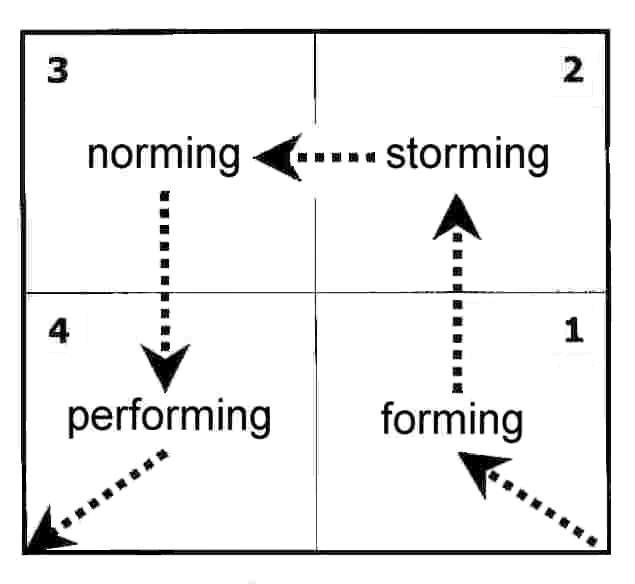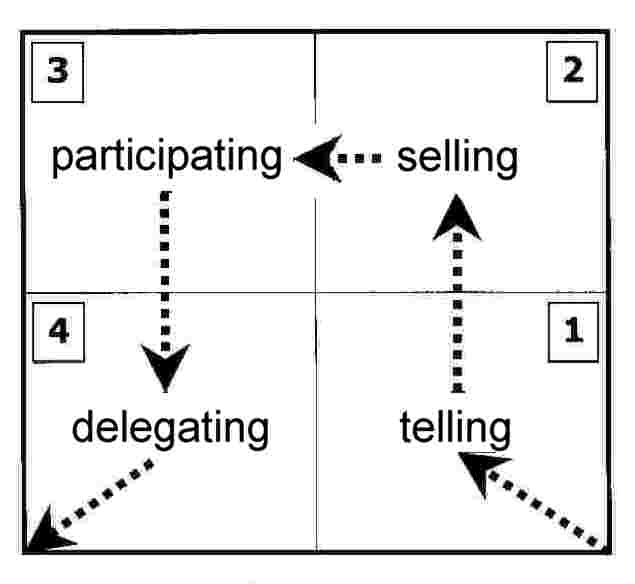
Dr Bruce Tuckman published his Forming Storming Norming Performing model in 1965. He added a fifth stage, Adjourning, in the 1970's. The Forming Storming Norming Performing theory is an elegant and helpful explanation of team development and behaviour. Similarities can be seen with other models, such as Tannenbaum and Schmidt Continuum and especially with Hersey and Blanchard's Situational Leadership® model, developed about the same time.
Tuckman's model explains that as the team develops maturity and ability, relationships establish, and the leader changes leadership style. Beginning with a directing style, moving through coaching, then participating, finishing delegating and almost detached. At this point the team may produce a successor leader and the previous leader can move on to develop a new team. This progression of team behaviour and leadership style can be seen clearly in the Tannenbaum and Schmidt Continuum - the authority and freedom extended by the leader to the team increases while the control of the leader reduces. In Tuckman's Forming Storming Norming Performing model, Hersey's and Blanchard's Situational Leadership® model and in Tannenbaum and Schmidt's Continuum, we see the same effect, represented in three ways.
tuckman's forming storming norming performing model - original model
The progression is:
forming
storming
norming
performing
Features of each phase:
forming - stage 1
High dependence on leader for guidance and direction. Little agreement on team aims other than received from leader. Individual roles and responsibilities are unclear. Leader must be prepared to answer lots of questions about the team's purpose, objectives and external relationships. Processes are often ignored. Members test tolerance of system and leader. Leader directs (similar to Situational Leadership® 'Telling' mode).
storming - stage 2
Decisions don't come easily within group. Team members vie for position as they attempt to establish themselves in relation to other team members and the leader, who might receive challenges from team members. Clarity of purpose increases but plenty of uncertainties persist. Cliques and factions form and there may be power struggles. The team needs to be focused on its goals to avoid becoming distracted by relationships and emotional issues. Compromises may be required to enable progress. Leader coaches (similar to Situational Leadership® 'Selling' mode).
norming - stage 3
Agreement and consensus is largely forms among team, who respond well to facilitation by leader. Roles and responsibilities are clear and accepted. Big decisions are made by group agreement. Smaller decisions may be delegated to individuals or small teams within group. Commitment and unity is strong. The team may engage in fun and social activities. The team discusses and develops its processes and working style. There is general respect for the leader and some of leadership is more shared by the team. Leader facilitates and enables (similar to the Situational Leadership® 'Participating' mode).
performing - stage 4
The team is more strategically aware; the team knows clearly why it is doing what it is doing. The team has a shared vision and is able to stand on its own feet with no interference or participation from the leader. There is a focus on over-achieving goals, and the team makes most of the decisions against criteria agreed with the leader. The team has a high degree of autonomy. Disagreements occur but now they are resolved within the team positively and necessary changes to processes and structure are made by the team. The team is able to work towards achieving the goal, and also to attend to relationship, style and process issues along the way. team members look after each other. The team requires delegated tasks and projects from the leader. The team does not need to be instructed or assisted. Team members might ask for assistance from the leader with personal and interpersonal development. Leader delegates and oversees (similar to the Situational Leadership® 'Delegating' mode).
Tuckman's fifth stage - Adjourning
Bruce Tuckman refined his theory around 1975 and added a fifth stage to the Forming Storming Norming Performing model - he called it Adjourning, which is also referred to as Deforming and Mourning. Adjourning is arguably more of an adjunct to the original four stage model rather than an extension - it views the group from a perspective beyond the purpose of the first four stages. The Adjourning phase is certainly very relevant to the people in the group and their well-being, but not to the main task of managing and developing a team, which is clearly central to the original four stages.
adjourning - stage 5
Tuckman's fifth stage, Adjourning, is the break-up of the group, hopefully when the task is completed successfully, its purpose fulfilled; everyone can move on to new things, feeling good about what's been achieved. From an organizational perspective, recognition of and sensitivity to people's vulnerabilities in Tuckman's fifth stage is helpful, particularly if members of the group have been closely bonded and feel a sense of insecurity or threat from this change. Feelings of insecurity would be natural for people with high 'steadiness' attributes (as regards the 'four temperaments' or DISC model) and with strong routine and empathy style (as regards the Benziger thinking styles model, right and left basal brain dominance).
Hersey's and Blanchard's Situational Leadership® model

The classic Situational Leadership® model of management and leadership style also illustrates the ideal development of a team from immaturity (stage 1) through to maturity (stage 4) during which management an leadership style progressively develops from relatively detached task-directing (1), through the more managerially-involved stages of explanation (2) and participation (3), to the final stage of relatively detached delegation (4), at which time ideally the team is largely self-managing, and hopefully contains at least one potential management/leadership successor.
The aim of the leader or manager is therefore to develop the team through the four stages, and then to move on to another role.
Ironically this outcome is feared by many managers. However, good organisations place an extremely high value on leaders and managers who can achieve this.
The model also illustrates four main leadership and management styles, which a good leader is able to switch between, depending on the sitution (ie., the team's maturity relating to a particular task, project or challenge.)
Situational Leadership® is a trademark of the Center for Leadership Studies, which represents the interests and products of Dr Paul Hersey. Ken Blanchard (who incidentally wrote 'The One Minute Manager') went on to develop the Situational Leadership® system into what he called Situational Leadership II®, and which now covers a range of products marketed by his organization, The Ken Blanchard Companies.
 RADAR CHART/SPIDER CHART
RADAR CHART/SPIDER CHART 




